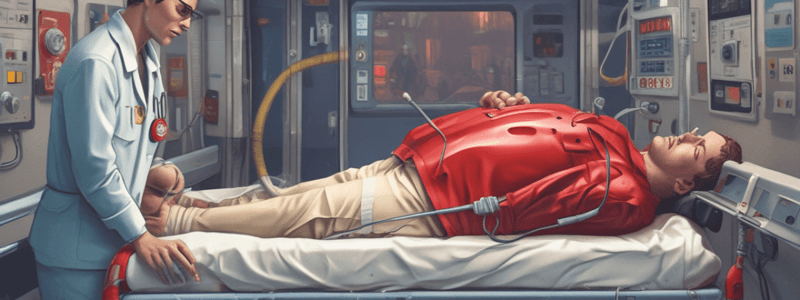Podcast
Questions and Answers
What is the primary goal of administering a fluid bolus of normal saline following ROSC?
What is the primary goal of administering a fluid bolus of normal saline following ROSC?
- To treat arrhythmias
- To prevent STEMI
- To reduce the risk of hyperventilation
- To increase blood pressure to at least 90 mmHg (correct)
What should be monitored continuously after ROSC?
What should be monitored continuously after ROSC?
- Only SpO2
- SpO2 and CO2 waveform capnography (correct)
- ECG only
- Only CO2 waveform capnography
What is the recommended dose of lidocaine for treating frequent or multifocal PVCs after ROSC?
What is the recommended dose of lidocaine for treating frequent or multifocal PVCs after ROSC?
- 2 mg/kg IV bolus
- 1 mg/kg IV bolus (correct)
- 0.5 mg/kg IV bolus
- No lidocaine is recommended
What should be done if the patient remains unconscious and is not pregnant after successful resuscitation of an atraumatic cardiac arrest?
What should be done if the patient remains unconscious and is not pregnant after successful resuscitation of an atraumatic cardiac arrest?
Why is a 12-lead ECG recommended after ROSC?
Why is a 12-lead ECG recommended after ROSC?
What is the concentration of premixed dopamine in D5W?
What is the concentration of premixed dopamine in D5W?
Why is routine administration of anti-arrhythmics following ROSC not indicated?
Why is routine administration of anti-arrhythmics following ROSC not indicated?
What is the primary goal of evaluating the patient after ROSC?
What is the primary goal of evaluating the patient after ROSC?
What is the first step in evaluating the patient after ROSC?
What is the first step in evaluating the patient after ROSC?
What is the recommended action if the patient's systolic BP remains less than 90 mmHg after administering two normal saline boluses?
What is the recommended action if the patient's systolic BP remains less than 90 mmHg after administering two normal saline boluses?
What is the primary reason for performing a 12-lead ECG after ROSC?
What is the primary reason for performing a 12-lead ECG after ROSC?
What should be done if the patient has frequent or multifocal PVCs after ROSC?
What should be done if the patient has frequent or multifocal PVCs after ROSC?
Why is it important to monitor CO2 waveform capnography after ROSC?
Why is it important to monitor CO2 waveform capnography after ROSC?
What is the primary goal of administering premixed dopamine after ROSC?
What is the primary goal of administering premixed dopamine after ROSC?
Why is it important to transport all ROSC patients to a STEMI center?
Why is it important to transport all ROSC patients to a STEMI center?
What should be done if a STEMI is detected on the 12-lead ECG after ROSC?
What should be done if a STEMI is detected on the 12-lead ECG after ROSC?
Flashcards are hidden until you start studying
Study Notes
Post-ROSC Evaluation and Treatment
- After successful resuscitation (ROSC), evaluate for presence of carotid pulse and adequate ventilation/oxygenation, avoiding hyperventilation.
- Monitor SpO2 and CO2 waveform capnography continuously.
- Obtain blood pressure if there is a carotid pulse.
Arrhythmia Treatment
- Treat arrhythmias according to the appropriate protocol.
- Administer lidocaine, 1 mg/kg IV bolus, for frequent (more than 6/minute) or multifocal PVCs, and repeat at half dose in 10 minutes if indicated.
Blood Pressure Management
- Administer a fluid bolus of normal saline, 500 mL IV/IO, if systolic BP is less than 90 mmHg, and repeat once if necessary.
- If normal saline boluses are not successful, administer premixed dopamine, 400 mg in 250 mL D5W (1,600 mcg/mL), starting at 30 drops per minute and titrating until BP is equal to or greater than 90 mmHg systolic.
ECG and STEMI Alert
- Perform a 12-lead ECG if time permits, and call a STEMI Alert immediately if a STEMI is present.
- Transport all ROSC patients to a STEMI center, even if there is no ST segment elevation, but only call a STEMI Alert if there is ST segment elevation.
Additional Considerations
- Attempt to determine and treat the underlying causes of the cardiac arrest.
- Consider an ICE ALERT to the STEMI Center for unconscious patients who are not pregnant after successful resuscitation of an atraumatic cardiac arrest.
Post-ROSC Evaluation and Treatment
- After successful resuscitation (ROSC), evaluate for presence of carotid pulse and adequate ventilation/oxygenation, avoiding hyperventilation.
- Monitor SpO2 and CO2 waveform capnography continuously.
- Obtain blood pressure if there is a carotid pulse.
Arrhythmia Treatment
- Treat arrhythmias according to the appropriate protocol.
- Administer lidocaine, 1 mg/kg IV bolus, for frequent (more than 6/minute) or multifocal PVCs, and repeat at half dose in 10 minutes if indicated.
Blood Pressure Management
- Administer a fluid bolus of normal saline, 500 mL IV/IO, if systolic BP is less than 90 mmHg, and repeat once if necessary.
- If normal saline boluses are not successful, administer premixed dopamine, 400 mg in 250 mL D5W (1,600 mcg/mL), starting at 30 drops per minute and titrating until BP is equal to or greater than 90 mmHg systolic.
ECG and STEMI Alert
- Perform a 12-lead ECG if time permits, and call a STEMI Alert immediately if a STEMI is present.
- Transport all ROSC patients to a STEMI center, even if there is no ST segment elevation, but only call a STEMI Alert if there is ST segment elevation.
Additional Considerations
- Attempt to determine and treat the underlying causes of the cardiac arrest.
- Consider an ICE ALERT to the STEMI Center for unconscious patients who are not pregnant after successful resuscitation of an atraumatic cardiac arrest.
Studying That Suits You
Use AI to generate personalized quizzes and flashcards to suit your learning preferences.




